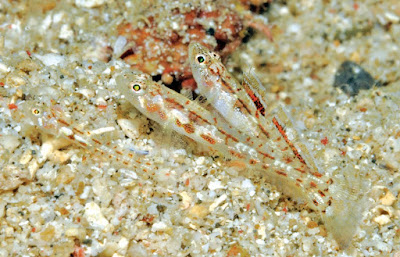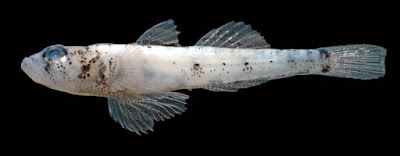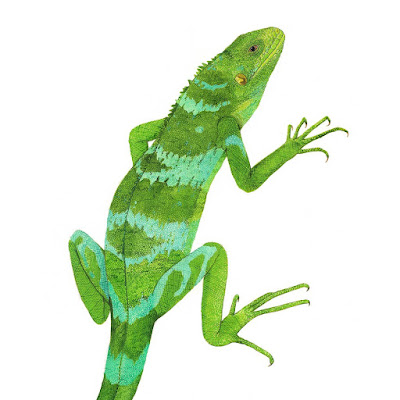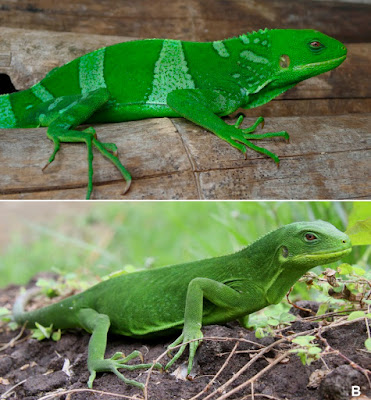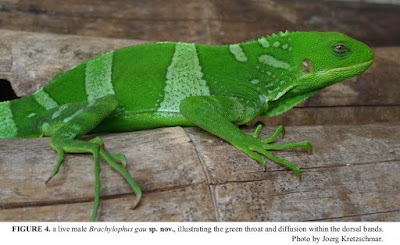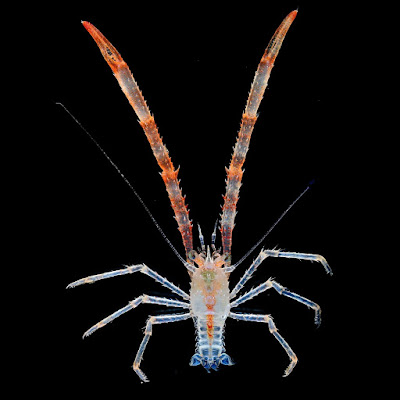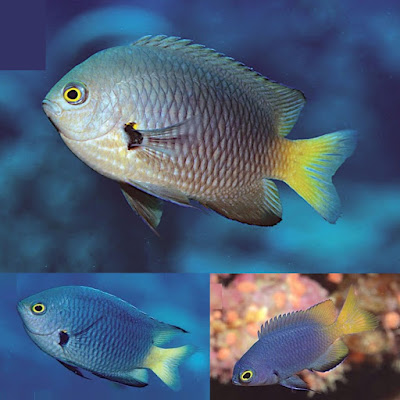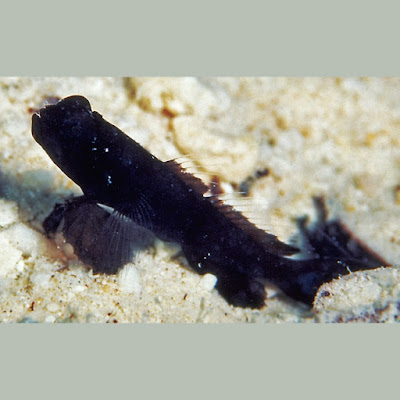 |
| Grallenia rubrilineata Allen & Erdmann, 2017 |
Abstract
Five new species belonging to the gobiid fish genus Grallenia of the tropical western Pacific Ocean are described from sand-bottom habitats. Grallenia compta n. sp. (11 specimens, 14.9–17.3 mm SL) from Milne Bay Province, Papua New Guinea and Grallenia rubrilineata n. sp. (81 specimens, 8.8–15.8 mm SL) from Luzon, Philippines share a suite of features that comprises an absence of cephalic sensory-canal pores, a rectangular first dorsal fin without a filamentous extension of the first spine, and the anterior and posterior scales separated by a scaleless gap, with 15–22 longitudinal scales in the posterior series. The two species differ from each other in dorsal- and anal fin-ray counts (8–9 for G. compta n. sp. vs. 9–11, usually 10, for G. rubrilineata n. sp.), scalation patterns, and coloration. A third new species, Grallenia dimorpha n. sp. (34 specimens, 9.8–16.7 mm SL) from Papua New Guinea is similar, except it has a continuous series of longitudinal scales without a gap, and females possess a triangular first dorsal fin featuring a filamentous extension of the first spine. The last two species, Grallenia lauensis n. sp. (two females, 11.1–11.4 mm SL) and Grallenia solomonensis n. sp. (three females, 11.4–12.5 mm SL), are described from Fiji and the Solomon Islands, respectively. They exhibit similar diagnostic features including the presence of cephalic sensory-canal pores, usually 7 segmented dorsal- and anal-fin rays, and most body scales restricted to the caudal peduncle. Grallenia solomonensis n. sp. differs from G. lauensis n. sp. in having several mid-lateral scales immediately behind the pectoral-fin base (vs. none), 16 (vs. 15) pectoral-fin rays, pelvic-fin rays with 2–3 branch points (vs. a single point), and a truncate (vs. slightly emarginate) caudal fin. An additional 33 non-type specimens, 7.0–15.6 mm SL, from Australia (southern Great Barrier Reef and northwestern Coral Sea) are provisionally identified as G. lauensis n. sp. However, at least some Australian specimens differ slightly in possessing branched segmented dorsal-fin rays and pelvic-fin rays with more than one branch point. Although fins are damaged in most specimens, two Australian males exhibit a long, filamentous first dorsal-fin spine.
Key words: taxonomy, systematics, ichthyology, coral-reef fishes, Indo-Pacific Ocean, Papua New Guinea, Philippines, Solomon Islands, Fiji, Australia, sand habitat
Grallenia compta, n. sp.
Ornamented Goby
Etymology. The species is named compta (Latin: ornamented), with reference to the orange markings on the head, body, and fins. It is treated as a feminine singular adjective.
Distribution and habitat. The new species is currently known only from Sideia Island in Milne Bay Province of Papua New Guinea (Fig. 6), but is no doubt more widespread in this large marine province. The habitat consists of large (5–10 m2 ), flat, sandy areas surrounded by live coral, in depths of about 14–15 m.

Figure 5: Adult males of species of Grallenia: A) G. compta; B) G. dimorpha; C) G. rubrilineata (G.R. Allen & M.V. Erdmann).
 |
| Figure 10. Grallenia dimorpha, male (upper) and female (lower), approx. 15 mm SL, underwater photographs in 16 m, White Island, West New Britain Province, Papua New Guinea (G.R. Allen). |
Grallenia dimorpha, n. sp.
Dimorphic Goby
Etymology. The species is named dimorpha (Latin: two shapes) with reference to the sexual dimorphism in relation to dorsal-fin shape. It is treated as a feminine singular adjective.
Distribution and habitat. The new species is currently known only from Papua New Guinea (Fig. 6). The type series was collected off the southern coast of New Britain Island and the non-type specimens from the vicinity of Madang and near Port Moresby. The habitat consists of sandy substrate in about 8–18 m.
 |
| Figure 14. Grallenia lauensis, female, approx. 11 mm SL, underwater photographs in 30–35 m, Lau Archipelago, Fiji (M.V. Erdmann). |
Grallenia lauensis, n. sp.
Lau Goby
Etymology. The species is named lauensis with reference to the Lau Archipelago type locality.
Distribution and habitat. The new species is currently known from the southern Lau Archipelago of southeastern Fiji and 33 non-type specimens from the Great Barrier Reef and northwestern Coral Sea. The Lau habitat consists of extensive gradual slopes of clean white sand in 30–35m depth. Both Lau sites were located in channel passes from the outer reef to extensive inner lagoons, and were hence subject to frequent strong currents and high rates of water exchange.
Grallenia rubrilineata, n. sp.
Redstripe Goby
Etymology. The species is named rubrilineata (Latin: “red-lined” or “red-striped”), with reference to the characteristic marking on the dorsal fin of adult males. It is treated as a feminine compound adjective.
Distribution and habitat. The new species is currently known from the Philippines, including the type locality near Anilao in Batangas Province, Luzon, and on the basis of a photograph from Dauin, Negros in the Central Visayas Group. A female specimen examined at WAM (P.30410-015), 18 mm SL, from Bohaydulong Island, Sabah State, Malaysia is probably G. rubrilineata, judging from fin-ray counts, scale pattern, and lack of head pores; however, additional specimens, including males, would be required to verify this identification. The habitat at Anilao consists of extensive areas of sand/silt substrate in about 12–15 m. The new species was very abundant in some areas, including the type locality, with an estimated abundance of 10–15 individuals per square meter. It was typically seen in small groups.
Grallenia solomonensis, n. sp.
Solomons Goby
Etymology. The species is named solomonensis with reference to the Solomon Islands type locality.
Gerald R. Allen and Mark V. Erdmann. 2017. Description of Five New Species of Marine Gobies (Teleostei: Gobiidae) of the Genus Grallenia from the tropical western Pacific Ocean. Journal of the Ocean Science Foundation. 27; 20–47. http://www.oceansciencefoundation.org/josf27c.html
---------------------------------------------------------------
روابط التحميل والمشاهدة، الروابط المباشرة للتحميل
او
شاهد هذا الفيديو القصير لطريقة التحميل البسيطة
كيف تحصل على مدونة جاهزة بآلاف المواضيع والمشاركات من هنا
شاهد قناة منتدى مدونات بلوجر جاهزة بألاف المواضيع والمشاركات على اليوتيوب لمزيد من الشرح من هنا
رابط مدونة منتدى مدونات بلوجر جاهزة بآلاف المواضيع والمشاركات في أي وقت حــــتى لو تم حذفها من هنا
شاهد صفحة منتدى مدونات بلوجر جاهزة بألاف المواضيع والمشاركات على الفيس بوك لمزيد من الشرح من هنا
شاهد صفحة منتدى مدونات بلوجر جاهزة بألاف المواضيع والمشاركات على الفيس بوك لمزيد من الشرح من هنا
تعرف على ترتيب مواضيع منتدى مدونات بلوجر جاهزة بآلاف المواضيع والمشاركات (حتى لا تختلط عليك الامور) من هنا
ملاحظة هامة: كل عمليات تنزيل، رفع، وتعديل المواضيع الجاهزة تتم بطريقة آلية، ونعتذر عن اي موضوع مخالف او مخل بالحياء مرفوع بالمدونات الجاهزة بآلاف المواضيع والمشاركات، ولكم ان تقوموا بحذف هذه المواضيع والمشاركات والطريقة بسيطة وسهلة. ــــــــــــــــــــــــــــــــــــــــــــــــــــــــــــــــــــــــــــــسلامـ.






